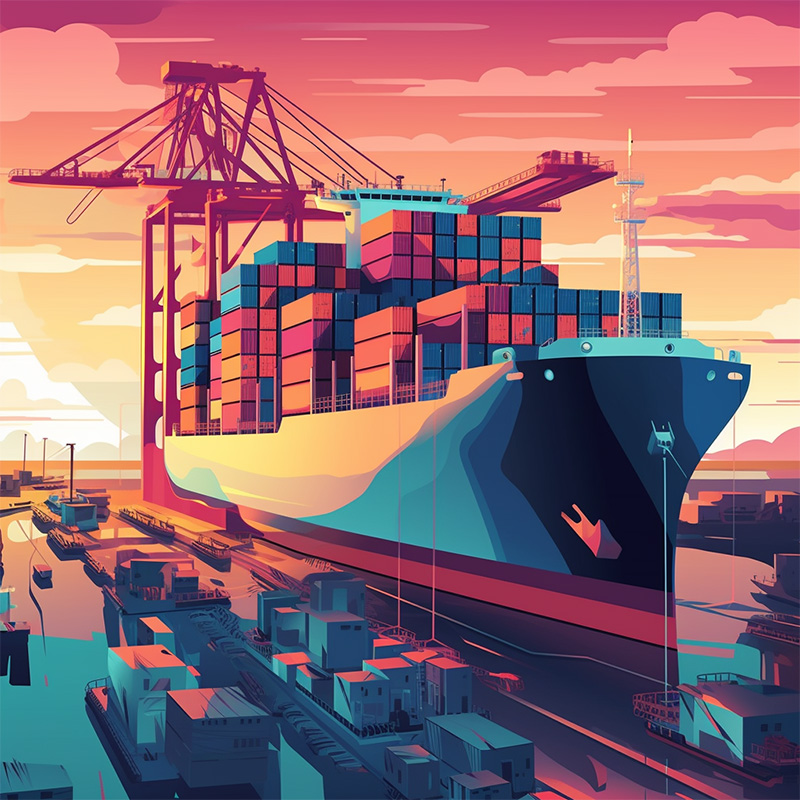Our Data Pipeline
A deep dive into the VesselMind data pipeline workflow
A journey through the innards of VesselMind's comprehensive data processing system that simplifies vessel schedule management for shipping lines, logistics companies, port authorities, and regulatory agencies.
In the rapidly evolving landscape of the shipping industry, accessing real-time, reliable vessel schedule data is vital for effectively managing logistics operations. VesselMind offers state-of-the-art APIs and notifications that enable companies to seamlessly integrate vessel schedule data into their existing logistics management systems. In this article, we'll delve into the intricate steps involved in VesselMind's data processing system, discuss common problems with incoming data, and explore how our platform helps clients effortlessly access accurate and up-to-date information.

Part 1: Challenges with Source Data
Working with data from various sources can be challenging due to several factors. In this section, we'll discuss some common problems with incoming data and how VesselMind's data processing system tackles them.
Hard-to-access dataMany data sources do not provide easy access to their information, making it difficult for clients to obtain the data they need. VesselMind's data aggregation process addresses this issue by gathering and consolidating data from multiple sources into a single, comprehensive repository.
Lack of APIsThe absence of APIs from some data sources can hinder seamless integration with clients' logistics management systems. VesselMind's API-driven platform enables users to effortlessly access the required data and integrate it into their existing systems.
Non-standard formatsVessel schedule data often comes in various formats, which can be challenging to work with. VesselMind's data transformation process standardizes the format of the collected data, ensuring that it's consistent and easily usable.
Missing data/fieldsSometimes, incoming data might have missing fields or incomplete information. VesselMind's data transformation stage includes predicting missing data, filling in the gaps, and ensuring that the final output is as complete and accurate as possible.
Inconsistent formattingData from different sources may have unconventional formatting or discrepancies that can cause issues during processing. VesselMind's data cleanup process addresses these issues, ensuring that the final data output is clean, accurate, and consistent.
Part 2: The Data Processing Workflow
Here is a highly simplified view of our high level data processing workflow. We'll dive into each stage in detail in the next section.

1. Primary Data Sources: Data Aggregation
The data aggregation stage involves collecting and combining data from various primary sources like ports, terminals, and service lines. By tapping into these diverse sources, VesselMind can generate a comprehensive and accurate view of vessel schedules. Aggregating data from multiple sources enables the platform to identify discrepancies, fill in gaps, and provide a more reliable dataset for clients.
One of the challenges in this stage is to establish seamless connections with various data sources while overcoming potential barriers such as different data access protocols, security requirements, or limited access permissions. VesselMind's data aggregation process effectively navigates these challenges by employing a robust and adaptable framework that can easily interface with different data sources.
2. Secondary Data Sources: Data Enrichment
Data enrichment is a crucial step in enhancing the quality and value of the aggregated data. By incorporating secondary data sources such as AIS, third-party public feeds, and private feeds, VesselMind can add depth and context to the primary data, ensuring clients have access to more detailed and accurate information.
In this stage, VesselMind carefully selects and integrates relevant secondary data sources to complement and support the primary data. The data enrichment process involves filtering, validating, and cross-referencing the additional data, ensuring it is relevant and accurate before integrating it into the primary dataset.
3. Data Deduplication
Duplicate data can negatively impact data quality and result in misleading insights. VesselMind's data deduplication process employs advanced algorithms and data comparison techniques to identify and eliminate duplicate records within the aggregated dataset. By systematically removing redundancies, VesselMind ensures that the stored data is clean, accurate, and easier to work with.
Deduplication can be a complex task, as it requires identifying matching records across diverse data sources, formats, and structures. VesselMind's deduplication process overcomes these challenges by leveraging sophisticated data matching techniques and a deep understanding of the underlying data structures and semantics.
4. Data Transformation
Data transformation is an essential step that refines and standardizes the aggregated and enriched data. This process involves a series of tasks, including data cleanup, format standardization, time format conversions, predicting missing data, and addressing source-specific data bugs and formatting issues.
During data cleanup, VesselMind removes inconsistencies, inaccuracies, and errors in the data, ensuring that the final output is accurate and reliable. Format standardization ensures consistency across data from various sources, making it more accessible and usable for clients. Time format conversions harmonize various time representations, enabling accurate and efficient comparisons and analysis of time-sensitive data.
5. Persistence and Client Access
Persistence is the final stage in VesselMind's data processing pipeline, where the transformed data is securely stored and made accessible to clients. This stage includes three main components:
Primary Store & APIsThe primary store serves as the main data repository, ensuring that the processed data is securely stored and readily available for clients to access via VesselMind's API.
Change Detection & NotificationsVesselMind continuously monitors the stored data for any changes or updates, enabling clients to receive timely notifications about schedule alterations.
History Tables & AnalyticsVesselMind also maintains historical records of vessel schedules, allowing for in-depth analysis and reporting. Although these services are not currently available to clients, VesselMind plans to open up access to historical data and analytics in the near future, providing clients with even more valuable insights and information.
In the near future, VesselMind plans to provide clients with access to analytics and historical data, further enhancing their ability to make informed decisions and streamline their operations.
Part 3: The Future of VesselMind's Data Services
Currently, clients can consume VesselMind's API and notifications to access real-time, reliable vessel schedule data and stay informed about changes and updates. However, the future holds even more exciting developments for VesselMind's data services. Here are some key areas of expansion and improvement that clients can look forward to:
Enhanced Analytics and Historical Data AccessVesselMind plans to open up access to historical data and analytics, providing clients with a treasure trove of valuable insights and information. By analyzing historical trends and patterns, clients will be able to identify bottlenecks, optimize operations, and make data-driven decisions to improve efficiency and reduce costs. This new offering will enable clients to gain a deeper understanding of vessel movements, market trends, and other factors that influence their business.
Machine Learning and AI-Driven PredictionsIn the future, VesselMind aims to leverage advanced machine learning and AI techniques to provide clients with predictive analytics capabilities. By analyzing vast amounts of historical and real-time data, these sophisticated algorithms can identify patterns and trends that can be used to forecast vessel schedules, anticipate delays, and optimize route planning. This will enable clients to proactively address potential issues, improve operational efficiency, and ultimately enhance their competitive advantage.

Expansion of Data Sources and CoverageVesselMind is continuously working to expand its data sources and coverage, ensuring that clients have access to the most comprehensive and up-to-date information available. This includes integrating new data streams from emerging technologies such as IoT devices, satellite imagery, and advanced tracking systems. By continuously expanding its data sources, VesselMind will provide clients with even more accurate and complete information, further enhancing the value of its data services.
Customizable Data Services and ReportingTo better cater to the diverse needs of its clients, VesselMind plans to develop customizable data services and reporting tools. Clients will be able to tailor data feeds, notifications, and reports to their specific requirements, ensuring they receive only the most relevant and useful information. This level of personalization will enable clients to focus on the data that matters most to their operations, maximizing efficiency and reducing information overload.
Improved Data Security and ComplianceAs data security and privacy concerns continue to grow, VesselMind is committed to enhancing its data protection measures and ensuring compliance with all relevant regulations. This includes implementing cutting-edge security technologies, establishing strict access controls, and continuously monitoring data for potential vulnerabilities. By prioritizing data security and compliance, VesselMind will ensure that clients can trust the integrity and confidentiality of their data.
The future of VesselMind's data services promises to deliver even greater value and insights to its clients. By expanding its offerings and continuously improving its data processing capabilities, VesselMind will remain at the forefront of the industry, providing clients with the information they need to succeed in an increasingly competitive landscape.
